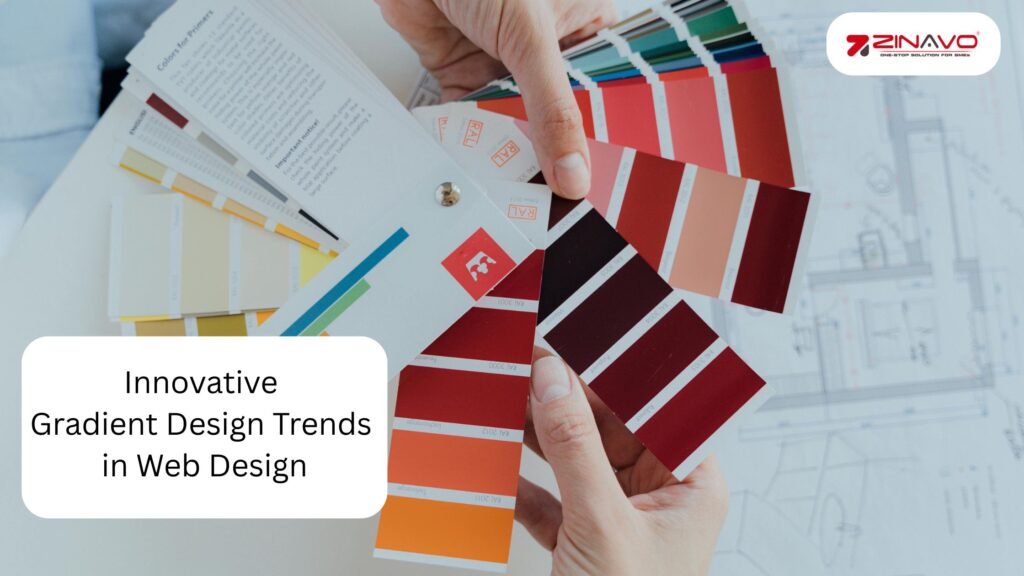Innovative gradient design trends in web design
Introduction:
Web designers are using gradients to create depth, dimension, and visual interest in their web designs. By blending colors seamlessly, gradients can transform flat interfaces into engaging experiences, guiding user attention and enhancing aesthetic appeal. From soft transitions to bold, vibrant overlays, incorporating gradients thoughtfully can elevate a website’s design, making it both modern and memorable.
What is a gradient in web design?
The gradient web design technique involves blending two or more colors carefully in order to achieve an intended design effect. This ultimately results in more aesthetically pleasing designs with a sense of depth. It is possible to use these design solutions anywhere in the background, UI elements, buttons, borders, and even typography to add depth and make them appear vibrant. Colors, tones, or even tints can be selected by designers in accordance with the idea and implementation of the design. There is no limit to what designers can achieve with gradients.
Why Use Gradients in Web Design?
Gradients enhance web design by adding depth, dimension, and visual interest, making websites more engaging and dynamic. They create smooth transitions between colors, guiding users’ attention and improving overall aesthetics. Additionally, gradients can evoke emotions and establish a modern, polished look, aligning with current design trends.
1. Creating new color schemes
Creating new color schemes enhances visual appeal and brand identity. Make use of color theory to create beautiful combinations, experiment with gradients, and test accessibility for readability. By using tools such as Coolors and Adobe Color, you will be able to generate unique palettes, ensuring a balanced and user-friendly design experience.
2. To attract visitors to the site
Focus on a visually appealing design, fast loading speed, and engaging content to attract visitors to a website. It is important to use eye-catching images, clear navigation, and strong calls-to-action on your website. Provide valuable, user-focused content to keep visitors engaged, optimize for SEO, and ensure mobile compatibility.
3. To assist visitors in focusing their attention
It is essential to use clear visual organization, contrasting colors, and strategic white space to help visitors focus their attention. Make key elements such as call-to-actions stand out by using bold fonts or gradients. Improve user engagement by simplifying navigation, reducing distractions and guiding them naturally to important content.
4. To create a more memorable design
Make your design memorable by keeping it simple, using unique visuals, and using a strong color palette. You can enhance the user experience by using engaging typography, smooth gradients, and interactive elements. It is important to ensure lasting impact and brand recognition by designing a layout with an intuitive navigation system.
Gradient Design Tools
Finally, let’s look at a few free gradient tools.
This is not a comprehensive collection, as there are probably hundreds more. Here are a few of my personal favorites, so bookmark them if you like them.
1. CSS Gradient – This tool generates CSS gradients and provides live previews and customization options.
2. UI Gradient – This collection of gradient presets has been handpicked for inspiration and ease of use.
3. Coolors Gradient Maker – An easy to use and powerful color palette and gradient generator which can be exported for various design purposes.
4. Gradient Hunt – A collection of trendy gradients for web and UI design created by users
Benefits of gradients in Web Design
Design appeal: Gradients can add depth to designs, making them look more interactive, vibrant, and sophisticated than flat colors.
Involvement: Gradient designs attract audience attention to webpage elements. Increased sales can be achieved by incorporating these in CTA buttons or creatively in the background.
Responsive design: Gradients can scale smoothly without losing clarity on various screen sizes, unlike images, making them more responsive.
Creative: Designers can use gradients to make websites more appealing to their clients by matching colors to their business ideas or existing color palettes.
Conclusion
Using innovative gradient design trends in web design can significantly enhance user engagement and brand perception. Using gradients thoughtfully can help designers create visually appealing interfaces that engage users and effectively communicate a brand’s identity. Keeping up with these changing trends ensures that web designs are contemporary, dynamic, and resonate with target audiences.



